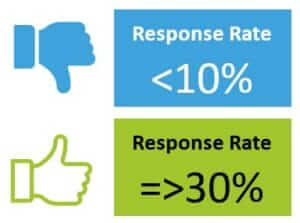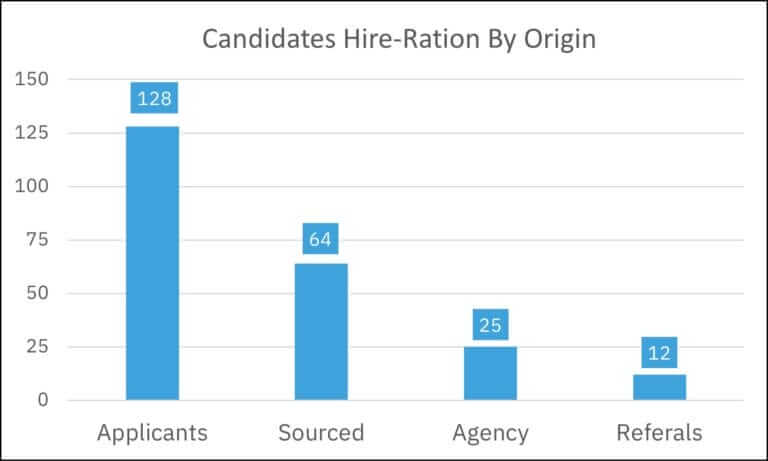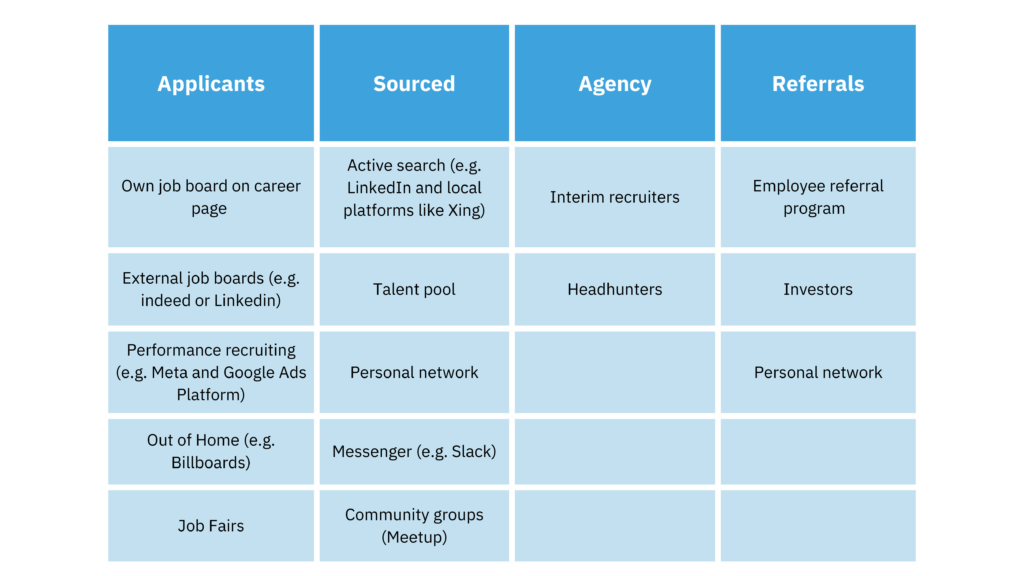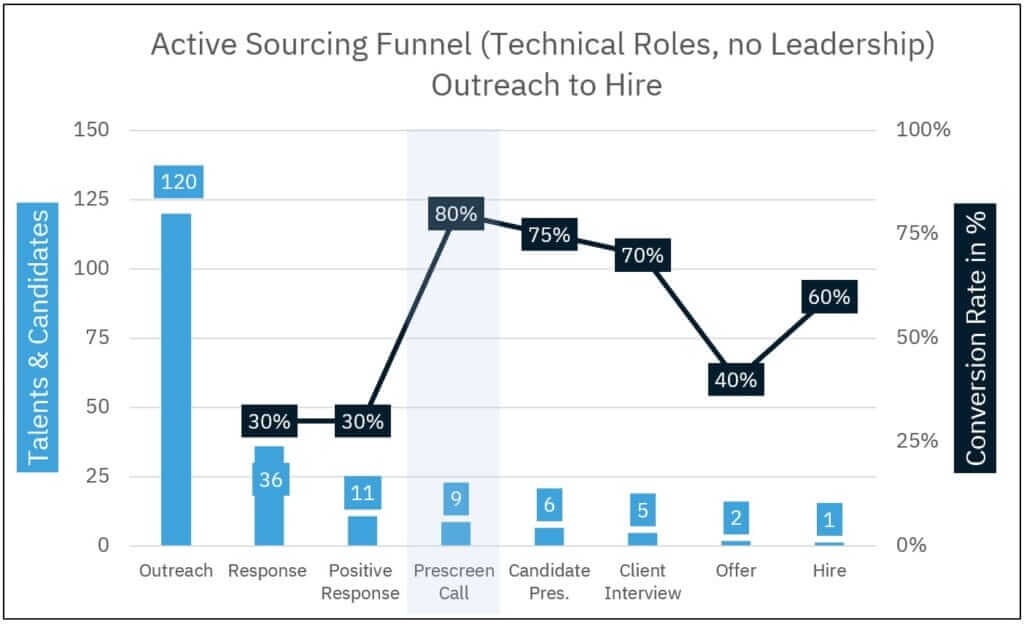1. Sourcing | Introduction

What is Sourcing all about? Simply put, it is about identifying & acquiring the candidates you are looking for. Basically, we can divide candidates into two groups: actively looking candidates (the applicants), and passive candidates (those who are not actively looking for a job change) who may be open for a conversation and need to be approached actively. In the following section, we will talk about recruiting channels, job advertisements, active sourcing, best practices and how to measure the success of sourcing.
2. Recruiting Channels
What is a recruiting channel? It is the source or origin from which you piped in your candidate in your ATS. As an example, the people from Lever (ATS Provider) split the recruiting channels into four main channels.
“Applicants: candidates who actively apply to an opportunity (either through a job board or careers page).
Referred candidates (or referrals) are introduced to the company through current employees and supporters (board members, partners, etc.).
Sourced candidates (also known as passive candidates) are those who are proactively approached by someone at the company (whether a recruiter or someone else) for a role.
Agency candidates are candidates found via third-party recruiting agencies”[1]
How to measure the success and efficiency of a recruiting channel? The success you can measure by hires per channel and efficiency by Hire Ratio Per Origin.
Hire Ratio Per Origin: According to a Lever study published in 2017: “Inside the Recruiting Funnel: Essential Metrics for Startups and SMBs”.[2] you will get a rough indication on how many candidates you need by channel to generate a hire (candidate signed the contract). Please bear in mind that the focus is limited to Hire-Ratio Efficiency. The data does not include parameters such as cost, time, priority of hiring for specific roles and differences of roles. It is an overall average.
“The fewer candidates you have to consider per successful hire, the better” (Lever 2017)
Why? Because there is simply less work to do. It is best to always have the perfect funnel in mind. 1 candidate, 1 Prescreen Call, 1 Hiring Manager Interview, 1 Offer, 1 Hire. We will likely never reach a 1 to 1 ratio, but we can think of it as an ideal scenario to orient on steadily streamlining our processes.
The main takeaway from this study is the efficiency of the referrals category. On average, 12 referred candidates were needed to fill a vacancy whereas, in comparison, an average of 128 applicants were needed to fill a vacancy.
To boost the referral category, you could implement or improve your employee referral program by promoting it to each employee constantly and incentivise it financially. 25 candidates needed by agencies seems to be an indicator that the collaboration can be improved by better briefing or asking for more senior consultants on the agencies’ site. The sourced category shows, that eventually ratios from inhouse recruiters may often beat the ratios of agency recruiters. The reason behind this? I suppose that being approached by an inhouse recruiter may seems to be more reliable for candidates than being approached by an agency recruiter. We recommend (at least for non-leadership roles) to avoid working with headhunters and instead to work with interim recruiters. By being embedded in your recruiting team, they get a more thorough understanding of your hiring needs, improving recruiting efficiency.
Adding up subcategories: the following overview shows the most common channels through which you may get your candidates.
IMPORTANT: While setting up your ATS, make sure that each origin/recruiting channel can be tracked to allow an analysis of where to best allocate the recruiting budget.
In the following sections we will primarily focus on LinkedIn and the Active Sourcing approach. Before we begin to focus on our inbound or outbound candidates, we need to publish a job advertisement, as this will be your pitch deck for your vacancy.
3. The Job Advertising
 Be specific, do not lie and tell a story: Focus on the tasks, challenges, current projects, tech stack (if it’s a technical role), name the hiring manager, team size and the core “must have” requirements. Do not waste your time looking for unrealistic profiles. Avoid blurry content. Do not distract the candidates by describing a chaotic structure as an agile environment. Be honest. The company description should be reduced to a summary of the mission & vision/purpose, industry, product employees, and vacancy location. Ideally you should have an Employer Value Proposition in place. The more unspecific the job ad is written, the more likely that a) candidates will apply who are not matching the requirements, just causing unnecessary work to process and b) potentially matching candidates may think you do not know what you are looking for and in the worst case not applying at all. Keep it lean and readable via mobile and desktop view.
Be specific, do not lie and tell a story: Focus on the tasks, challenges, current projects, tech stack (if it’s a technical role), name the hiring manager, team size and the core “must have” requirements. Do not waste your time looking for unrealistic profiles. Avoid blurry content. Do not distract the candidates by describing a chaotic structure as an agile environment. Be honest. The company description should be reduced to a summary of the mission & vision/purpose, industry, product employees, and vacancy location. Ideally you should have an Employer Value Proposition in place. The more unspecific the job ad is written, the more likely that a) candidates will apply who are not matching the requirements, just causing unnecessary work to process and b) potentially matching candidates may think you do not know what you are looking for and in the worst case not applying at all. Keep it lean and readable via mobile and desktop view.
3.1 Job Advertising | Tools

To get a consistent appearance of your job board, align on a fixed job advertising template and, if needed, a limited template range for specific role families. Experiment with the Job ads.
Here you can download a template for a best practice Job Advertisement.
3.2 Job Advertising | Recruiting Intelligence
 CTR (Click Through Rate): Most of your actively looking candidates will get in touch with your job advertisement through a variety of job boards. You want the right candidate to click the listing, read the ad and apply for the job. To track this, you can use the CTR to measure how many candidates click your job advertising, divided by impressions of unique visitors.
CTR (Click Through Rate): Most of your actively looking candidates will get in touch with your job advertisement through a variety of job boards. You want the right candidate to click the listing, read the ad and apply for the job. To track this, you can use the CTR to measure how many candidates click your job advertising, divided by impressions of unique visitors.
Smart Insights stated that career and employment related display ads on average have a CTR of 6,41%[3]. Keep in mind that this is a global average and may tremendously differ depending on your employer’s brand, the role itself and the ratio between open jobs and available candidates in a specific recruiting region.
Job title and Keywording (SEO): Evaluate the job title and keywords. Are they commonly used for that specific role? Use Google Trends to check most common job names that candidates are looking for, additionally research on job boards where similar jobs are published.[4] Matching your target group to your job title is crucial getting the impressions from the right candidates clicking the job advertisement, thereby increasing your CTR.
Test profiles: Based on experience, max. 50% of a role is clear after the briefing, so research test profiles to align with the Hiring Manager, whether or not you have the right profiles in mind. Set up a call to go through the researched profiles.
4. Active Sourcing
 Identifying candidates: An art of its own! Boolean logic will be your best friend. Have in mind that some platforms do not offer the full scope of Boolean functionality, even if they say so. Best to go through the common tutorials of your chosen platform. There are plenty of them[5].
Identifying candidates: An art of its own! Boolean logic will be your best friend. Have in mind that some platforms do not offer the full scope of Boolean functionality, even if they say so. Best to go through the common tutorials of your chosen platform. There are plenty of them[5].
I can also recommend my colleague Jenny Koller who has done multiple Active Sourcing onboardings at Kooku Recruiting Partners. If you interested, get in touch with her for more details: Active Sourcing Schulung.
Role Requirements and No Go’s: Before you start searching for candidates, make sure you have the core requirements, the nice to haves and no go’s of that role documented in a role requirements sheet. Focus on hard criteria that you can assess in publicly available candidate profiles.
Example: You are looking for a Fullstack JavaScript Developer.
Hard criteria:
Nice-to-haves: SQL, UI/UX Knowhow
No Go’s to assist your search: Exclude “Senior” developer, architects, and each position in the role hierarchy above like team lead software engineering or staff engineers. Also exclude Backend Engineers.
4.1 Active Sourcing | Tools

Platforms: LinkedIn, Xing, Github, StackOverflow, Goldenline.pl, Google
Role Requirement Form: The role requirements shall guide you through the search. Keep aligned.
Here you can download an example and a template for Role Requirements.
4.2 Active Sourcing | Best practices
“Low hanging fruits” approach: Start your search with candidates, who are signaling that they are open to work.
Boolean Search: As I mentioned, different platforms handle the Boolean Search capabilities differently. Be aware of that.
Venn Diagrams: Refresh your knowledge of set theory, to carve out your sample of candidates, which seems to be worthy to contact. Avoid doing the same things twice.
Domain Knowledge: If you are looking for a technical role (ie. JavaScript Developer with frontend focus) you should know what the difference is between it and the roles they interact with such as, UI/UX designers, Backend Developers, DevOPs Engineers and Product Owners. There may be a development path from a UI designer to frontend development, but it is most unlikely that a Product Owner will turn to a Frontend Developer. There may be edge cases, but the focus here is probability.
Also, have the technical ecosystem of your role in mind. If you are a looking for a React Developer and maybe React is not mentioned in the profile but JavaScript & Redux, you will know that this person probably uses either Angular or React[6]. Simply then ask the person. Another case, you are looking for a PHP Developer but instead of mentioning PHP in his/her profile, LAMP is listed[7]. If you have done your homework you know, it is a person you should consider.
Target company list: In the briefing, it is advised to ask your Hiring Manager for target companies (companies with the same product, where employees may have the same tasks so their onboarding may be faster). List those companies and start your search on that list. Use AI to support, like ChatGPT or do manual research. Also bear in mind any restricted companies, meaning companies you are not allowed to address, because those companies are partnering with your company or your client’s company.
4.3 Active Sourcing | Contacting the candidates
Based on your recruiting intelligence, you know whom to approach. Keep the outreach message as short as possible and as long as needed.
Outreach Message – Header: When I was working for a Fintech company which provides private loans, I needed to recruit a Head of BI. I found a matching profile at an ecommerce company selling kitchens.
My header was something like: “Join us as Head of BI! Without our loans, [candidate’s current employer] wouldn’t sell a single kitchen. 😉” Well, it worked out, the candidate was hired.
Outreach Message – Body: Start the Introduction, with a nice phrase like “Hope you are doing well” asking whether the role you recruit for could be interesting for the candidate. Give a reason why the profile could suit. Focus on the main projects, the company, product, number of employees, location and main benefits. Insert some links for further information. Don’t forget to integrate a self-scheduling link, so candidates can book an appointment on their own. No need for endless email ping pong. It is also beneficial to add a sentence like “it’s okay if the job is not matching” and request permission to invite the candidate to your network.
For another project I was recruiting for, I used the following template.
Start with a well suiting multi messaging approach and follow up with individualized messages to A-Profiles. Make sure the role is suited to the profile. Never forget, you are communicating to a real-life person not just a URL: Focus on the H in Human Resources not just the R. Design your message in the way you want to be approached yourself.
4.4 Active Sourcing | Recruiting Intelligence
 But how do you measure your success of outreach mailing campaigns? Through the Response Rate, Positive Response Rate and scheduled Prescreen Calls.
But how do you measure your success of outreach mailing campaigns? Through the Response Rate, Positive Response Rate and scheduled Prescreen Calls.
Of course, hiring the right candidate is a recruiter’s endgame, but if we talk about active sourcing, it is about getting talents converted to candidates and pre-assessing them in a prescreen call.
 Response Rate: The Response Rate is calculated (Responses/Outreach Messages) *100= Response Rate in %. If it’s below 10% go back to start and do your research. You can increase your response rate by following up messages. Also, have sessional effects in mind like holiday seasons, bank holidays or climate & geopolitical incidents. Some people go on holiday the right way, focusing on taking care of themselves and their beloved ones instead of checking e-mails.
Response Rate: The Response Rate is calculated (Responses/Outreach Messages) *100= Response Rate in %. If it’s below 10% go back to start and do your research. You can increase your response rate by following up messages. Also, have sessional effects in mind like holiday seasons, bank holidays or climate & geopolitical incidents. Some people go on holiday the right way, focusing on taking care of themselves and their beloved ones instead of checking e-mails.
Track your search history: Document your outreach campaign e-mail templates as well as the Search Strings to avoid redundant work.
The Active Sourcing Funnel (Technical Roles) – Outreach to Hire
The following data shall give you some guidelines on how to measure your active sourcing campaigns. These are our best case numbers regarding operational technical roles (ie. Developer) without leadership requirements.
When having all best practices in place, our best case active sourcing funnel for technical roles looks like this. We need around 120 outreach messages (excluding follow ups) to get around 36 (CR: 30%) responses in general consisting of 11 (CR: 30%) positive responses, which results in around 9 (CR: 80%) prescreen calls. The measure for active sourcing.
At Kooku, we incentive our active sourcers, when the recruiter have a prescreen call, as well as when we generate a client interview.
5. Preliminary Conclusion
When it comes to sourcing, the market offering on recruiting channels could be overwhelming. We recommend clustering your recruiting channels in main and subcategories. Each vacancy cluster may need different channels. Think about building a recruiting channel portfolio for each role cluster (Tech, Commercial etc.). Don’t forget to set up your ATS in a way that allows you to track the channels’ effectiveness and efficiency on a regular basis. Design a target group and an authentic job advertisement published on suitable recruiting channels. If you target passive or active candidates, make sure that the dedicated internal or external recruiter knows the domain to address the right talents, and is communicating at eye level with the candidates. Track your sourcing efforts steadily with a lean KPI set up to spot deviations and provide a solution proposal in time. Your internal or external clients will appreciate this.
Happy sourcing 😊
6. Footnotes
[1] https://s3-us-west-2.amazonaws.com/lever-assets/hire/Essential_Metrics_for_Startups_and_SMBs.pdf
[2] “This report aggregates data from approximately 1.5 million candidate considerations, 15,000 hires, and 600 Lever customers, from November 1, 2015 – November 1, 2016. Customers range in size from 1 to 200 employees when they began using Lever, and some began using Lever midway through the period studied. All data is used in aggregate and anonymously; no specific company or candidate data was exposed during the analysis.”
[3] https://www.smartinsights.com/internet-advertising/internet-advertising-analytics/display-advertising-clickthrough-rates/
[4] Stearing a performance based campaign on indeed or a little bit more challenging on the meta platforms with the Facebook Ad Manager won’t be part of this article.
[5] https://blog.linkedin.com/2007/07/15/5-tips-on-how-t, https://www.youtube.com/watch?v=XT72eew1U3o
[6] “Redux is an open-source JavaScript library for managing and centralizing application state. It is most commonly used with libraries such as React or Angular for building user interfaces.”
(https://en.wikipedia.org/wiki/Redux_(JavaScript_library))
[7] LAMP (Linux, Apache, MySQL, PHP/Perl/Python) is an acronym denoting one of the most common software stacks for many of the web’s most popular applications. (https://en.wikipedia.org/wiki/LAMP_(software_bundle))









